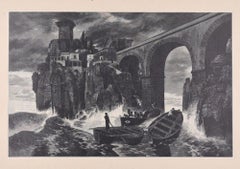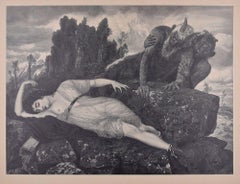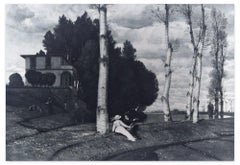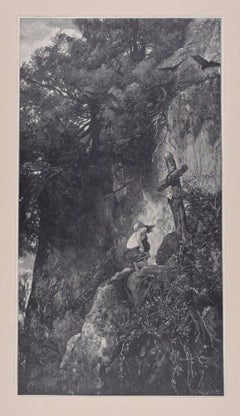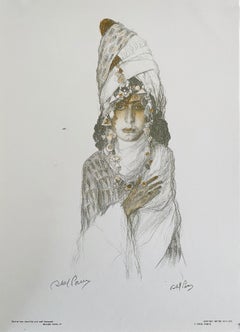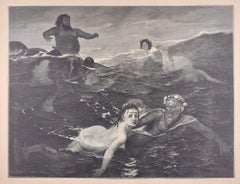Arnold Bocklin (After) Art
to
2
6
4
2
5
1
Overall Height
to
Overall Width
to
6
3
3
2
2
2
2
1
1
1
1
1
1
6
6
6,934
3,279
2,514
1,213
5
1
Artist: Arnold Bocklin (After)
Pirates attack the Castle on the Sea - Original Woodcut by J.J. Weber - 1898
By Arnold Bocklin (After)
Located in Roma, IT
Image dimensions: 23 x 35 cm.
Original Title: Von Piraten überfallene Burg am Meer
Pirates attack the Castle on the sea is a black and white xylograph on Japon applied on ivory-colored paper, after Arnold Böcklin...
Category
1890s Symbolist Arnold Bocklin (After) Art
Materials
Woodcut
The Neiads - Original Woodcut by J.J. Weber - 1898
By Arnold Bocklin (After)
Located in Roma, IT
Image dimensions: 24 x 27.8 cm
Original title: Die Najaden
The Neiads is a black and white xylograph on Japon applied on ivory-colored paper, after Arnold Böcklin, realized by the German artist Johann Jacob Weber (Basel 1803, Leipzig 1880).
A really superb plate with lifetime impression, from the collection "Sechzehn Holzscnitte nach Gemälden Arnold Böcklin (Meisterwerke der Holzschneidekunst, Neue Folge Heft V), leipzig, verlagsbuchhandlung von J.J. Weber", printed in 1898 by J.J. Weber.
All the plates of this print suite are woodcuts on the head wood and taken from Böcklin's most famous paintings.
Johann Jacob Weber was the talented executor and creator of the Meisterwerke der Holzschneidekunst series which also includes a famous folder of his woodcuts taken from the artworks by Sascha Schneider...
Category
1890s Symbolist Arnold Bocklin (After) Art
Materials
Woodcut
Sleeping Diana - Original Woodcut by J.J. Weber - 1898
By Arnold Bocklin (After)
Located in Roma, IT
Image dimensions: 34.2 x 45.5 cm.
Sleeping Diana is an original print, realized in 1898.
Black and white woodcut print on applied Japon paper.
Good conditions except for yellowing of paper (especially along the margins), and very light folds on lower left side.
The print was realized by Johann Jacob Weber and it's part of the series Meisterwerke der Holzschneidekunst (original title: SECHZEHN HOLZSCHNITTE NACH GEMÄLDEN ARNOLD BÖCKLIN...
Category
1890s Symbolist Arnold Bocklin (After) Art
Materials
Woodcut
Fruhling - Original Woodcut After Arnold Bocklin - 1890s
By Arnold Bocklin (After)
Located in Roma, IT
Frühling is a wonderful black and white photogravure of the original painting by Arnold Böcklin (Basel 1827 - Fiesole 1901), probably edited by Bruckman...
Category
1890s Symbolist Arnold Bocklin (After) Art
Materials
Lithograph
Der Büsser - Original Woodcut by J.J. Weber - 1898
By Arnold Bocklin (After)
Located in Roma, IT
Image dimensions: 34 x 19 cm.
Der Büsser is an original print, realized in 1898.
Black and white xylograph on applied Japon paper.
Good conditions except for yellowing of paper (especially along the margins), and little stains on lower margin.
The print was realized by Johann Jacob Weber and it's part of the series Meisterwerke der Holzschneidekunst (original title: SECHZEHN HOLZSCHNITTE NACH GEMÄLDEN ARNOLD BÖCKLIN...
Category
1890s Symbolist Arnold Bocklin (After) Art
Materials
Woodcut
Centaur In The Smithy - Original Woodcut by J.J. Weber - 1898
By Arnold Bocklin (After)
Located in Roma, IT
Image dimensions: 24.5 x 31.5 cm.
Centaur In The Smithy is an original print, realized in 1898.
Black and white xylograph on applied Japon paper.
Good conditions except for yellowing of paper (especially along the margins), and very light foxings on lower part of paper.
The print was realized by Johann Jacob Weber and it's part of the series Meisterwerke der Holzschneidekunst (original title: SECHZEHN HOLZSCHNITTE NACH GEMÄLDEN ARNOLD BÖCKLIN...
Category
1890s Symbolist Arnold Bocklin (After) Art
Materials
Woodcut
Related Items
Kraft und Mut (Courage and Strength), German antique engraving
Located in Melbourne, Victoria
'Kraft und Mut'
(Courage and Strength)
German wood-engraving, 1903.
320mm by 230mm (image)
280mm by 410mm (sheet)
Category
Early 20th Century Symbolist Arnold Bocklin (After) Art
Materials
Engraving
Abel Pann Israeli Bezalel School Lithograph Judaica Biblical Print Jewish Art
By Abel Pann
Located in Surfside, FL
Abel Pann (1883–1963) was a European Jewish painter who settled in the Talpiot neighborhood of Jerusalem in the early twentieth century and taught at the Bezalel Academy of Art under Boris Schatz.
Abba Pfeffermann (later Abel Pann), born in Latvia or in Kreskowka, Vitebsk, Belarus, was a European Russian Jewish art...
Category
Mid-20th Century Symbolist Arnold Bocklin (After) Art
Materials
Lithograph
Abel Pann Israeli Bezalel School Lithograph Judaica Biblical Print Jewish Art
By Abel Pann
Located in Surfside, FL
Abel Pann (1883–1963) was a European Jewish painter who settled in the Talpiot neighborhood of Jerusalem in the early twentieth century and taught at the Bezalel Academy of Art under...
Category
Mid-20th Century Symbolist Arnold Bocklin (After) Art
Materials
Lithograph
Die Nacht (The Night), nude and cupids, German antique engraving
By Virgilio Tojetti
Located in Melbourne, Victoria
'Die Nacht'
(The Night)
German wood-engraving, 1903.
310mm by 230mm (image)
410mm by 280mm (sheet)
Category
Early 20th Century Symbolist Arnold Bocklin (After) Art
Materials
Engraving
Die Nixen (Mermaids), nudes, German antique engraving
By Virgilio Tojetti
Located in Melbourne, Victoria
'Die Nixen'
(Mermaids)
German wood-engraving, 1903.
230mm by 320mm (image)
280mm by 410mm (sheet)
Category
Early 20th Century Symbolist Arnold Bocklin (After) Art
Materials
Engraving
Abel Pann Israeli Bezalel School Lithograph Judaica Biblical Print Jewish Art
By Abel Pann
Located in Surfside, FL
Abel Pann (1883–1963) was a European Jewish painter who settled in the Talpiot neighborhood of Jerusalem in the early twentieth century and taught at the Bezalel Academy of Art under...
Category
Mid-20th Century Symbolist Arnold Bocklin (After) Art
Materials
Lithograph
Abel Pann Israeli Bezalel School Lithograph Judaica Biblical Print Jewish Art
By Abel Pann
Located in Surfside, FL
Abel Pann (1883–1963) was a European Jewish painter who settled in the Talpiot neighborhood of Jerusalem in the early twentieth century and taught at the Bezalel Academy of Art under...
Category
Mid-20th Century Symbolist Arnold Bocklin (After) Art
Materials
Lithograph
Abel Pann Israeli Bezalel School Lithograph Judaica Biblical Print Jewish Art
By Abel Pann
Located in Surfside, FL
Abel Pann (1883–1963) was a European Jewish painter who settled in the Talpiot neighborhood of Jerusalem in the early twentieth century and taught at the Bezalel Academy of Art under...
Category
Mid-20th Century Symbolist Arnold Bocklin (After) Art
Materials
Lithograph
Abel Pann Israeli Bezalel School Lithograph Judaica Biblical Print Jewish Art
By Abel Pann
Located in Surfside, FL
Abel Pann (1883–1963) was a European Jewish painter who settled in the Talpiot neighborhood of Jerusalem in the early twentieth century and taught at the Bezalel Academy of Art under...
Category
Mid-20th Century Symbolist Arnold Bocklin (After) Art
Materials
Lithograph
Abel Pann Israeli Bezalel School Lithograph Judaica Biblical Print Jewish Art
By Abel Pann
Located in Surfside, FL
Abel Pann (1883–1963) was a European Jewish painter who settled in the Talpiot neighborhood of Jerusalem in the early twentieth century and taught at the Bezalel Academy of Art under...
Category
Mid-20th Century Symbolist Arnold Bocklin (After) Art
Materials
Lithograph
Abel Pann Israeli Bezalel School Lithograph Judaica Biblical Print Jewish Art
By Abel Pann
Located in Surfside, FL
Abel Pann (1883–1963) was a European Jewish painter who settled in the Talpiot neighborhood of Jerusalem in the early twentieth century and taught at the Bezalel Academy of Art under Boris Schatz.
Abba Pfeffermann (later Abel Pann), born in Latvia or in Kreskowka, Vitebsk, Belarus, was a European Russian Jewish artist who immigrated to Ottoman Palestine and settled in Jerusalem. He was married to Esther Nussbaum. Pann's youngest son was killed in the 1947–1949 Palestine war. After that loss, he turned to painting scenes of the Holocaust. He died in Jerusalem in 1963.
Pann studied the fundamentals of drawing for three months with the painter Yehuda Pen of Vitebsk, who also taught Marc Chagall. In his youth, he traveled in Russia and Poland, earning a living mainly as an apprentice in sign workshops. In 1898 he went south to Odessa, where he was accepted into the Academy of Fine Arts. In 1903, he was in Kishinev, where he documented the Kishinev pogrom with drawings; an effort that is thought to have contributed to his self-definition as an artist who chronicles Jewish history. Still in 1903, he moved to Paris, where he rented rooms in La Ruche, a Parisian building (which still exists) where Modigliani, Chagall, Chaim Soutine and other Jewish artists also lived. Pann studied at the French Academy under William-Adolphe Bouguereau. He earned his living primarily by drawing pictures for the popular illustrated newspapers of the era. In 1912, Boris Schatz, founder and director of the Bezalel Academy of Arts and Design visited Pann in Paris and invited him to come work in Jerusalem.
In 1913, after traveling in Southern Europe and Egypt, Pann arrived in Jerusalem, where he had decided to settle for life. Pann went to see Schatz and it was decided that he would head the painting department at the Bezalel Academy for several months while Schatz embarked on an extensive overseas fund-raising trip. According to Haaretz art critic Smadar Sheffi, a work form this period with the simple title "Jerusalem" shows a cluster of buildings at sunset "with a sky in blazing orange." The painting is "more expressive and abstract that is typical of his work," and Sheffi speculates that "the encounter with the city" of Jerusalem was a "strong emotional experience" for the artist. Pann returned to Europe to arrange his affairs before moving permanently to the British Mandate of Palestine, but was caught on the continent by World War I. Pann's wartime paintings would prove to be among "the most important" of his career. He made many posters to support the French war effort. He also made a series of fifty drawings showing the extreme suffering of Jewish communities caught in the fighting between Germany, Poland and Russia. Art critic Smadar Sheffi regards them as "the most important part of his oeuvre." These "shocking" drawings put modern viewers in mind of depictions of the Holocaust. Pann's drawings were intended as journalistic documentation of the fighting and were successfully exhibited in the United States during the War. According to Pann's autobiography, the Russians, who were allied with the French, refused to allow a wartime exhibition of the drawings in France. According to The New York Times, the drawings were published in Paris during the war, but the government intervened to block their distribution on the grounds that they "reflected damagingly upon an ally" (Russia).
Upon his return to Jerusalem in 1920, Pann took up a teaching position at the Bezalel Academy and wrote that he was about to embark on his life-work, the painting and drawing of scenes from the Hebrew Bible. He returned briefly to Vienna, where he met and married Esther Nussbaum and purchased a lithographic press, which the couple brought home to Jerusalem. Pann began work on a series of lithographs intended to be published in an enormous illustrated Bible, and although that series was never completed, he is widely admired for the series of pastels inspired by Bible stories that he began in the 1940s. The iconography of these works is linked to the 19th century orientalism. He was part of a movement of contemporary Jewish artists interested in Biblical scenes, including Ephraim Moses Lilien...
Category
Mid-20th Century Symbolist Arnold Bocklin (After) Art
Materials
Lithograph
Abel Pann Israeli Bezalel School Lithograph Judaica Biblical Print Jewish Art
By Abel Pann
Located in Surfside, FL
Abel Pann (1883–1963) was a European Jewish painter who settled in the Talpiot neighborhood of Jerusalem in the early twentieth century and taught at the Bezalel Academy of Art under Boris Schatz.
Abba Pfeffermann (later Abel Pann), born in Latvia or in Kreskowka, Vitebsk, Belarus, was a European Russian Jewish artist who immigrated to Ottoman Palestine and settled in Jerusalem. He was married to Esther Nussbaum. Pann's youngest son was killed in the 1947–1949 Palestine war. After that loss, he turned to painting scenes of the Holocaust. He died in Jerusalem in 1963.
Pann studied the fundamentals of drawing for three months with the painter Yehuda Pen of Vitebsk, who also taught Marc Chagall. In his youth, he traveled in Russia and Poland, earning a living mainly as an apprentice in sign workshops. In 1898 he went south to Odessa, where he was accepted into the Academy of Fine Arts. In 1903, he was in Kishinev, where he documented the Kishinev pogrom with drawings; an effort that is thought to have contributed to his self-definition as an artist who chronicles Jewish history. Still in 1903, he moved to Paris, where he rented rooms in La Ruche, a Parisian building (which still exists) where Modigliani, Chagall, Chaim Soutine and other Jewish artists also lived. Pann studied at the French Academy under William-Adolphe Bouguereau. He earned his living primarily by drawing pictures for the popular illustrated newspapers of the era. In 1912, Boris Schatz, founder and director of the Bezalel Academy of Arts and Design visited Pann in Paris and invited him to come work in Jerusalem.
In 1913, after traveling in Southern Europe and Egypt, Pann arrived in Jerusalem, where he had decided to settle for life. Pann went to see Schatz and it was decided that he would head the painting department at the Bezalel Academy for several months while Schatz embarked on an extensive overseas fund-raising trip. According to Haaretz art critic Smadar Sheffi, a work form this period with the simple title "Jerusalem" shows a cluster of buildings at sunset "with a sky in blazing orange." The painting is "more expressive and abstract that is typical of his work," and Sheffi speculates that "the encounter with the city" of Jerusalem was a "strong emotional experience" for the artist. Pann returned to Europe to arrange his affairs before moving permanently to the British Mandate of Palestine, but was caught on the continent by World War I. Pann's wartime paintings would prove to be among "the most important" of his career. He made many posters to support the French war effort. He also made a series of fifty drawings showing the extreme suffering of Jewish communities caught in the fighting between Germany, Poland and Russia. Art critic Smadar Sheffi regards them as "the most important part of his oeuvre." These "shocking" drawings put modern viewers in mind of depictions of the Holocaust. Pann's drawings were intended as journalistic documentation of the fighting and were successfully exhibited in the United States during the War. According to Pann's autobiography, the Russians, who were allied with the French, refused to allow a wartime exhibition of the drawings in France. According to The New York Times, the drawings were published in Paris during the war, but the government intervened to block their distribution on the grounds that they "reflected damagingly upon an ally" (Russia).
Upon his return to Jerusalem in 1920, Pann took up a teaching position at the Bezalel Academy and wrote that he was about to embark on his life-work, the painting and drawing of scenes from the Hebrew Bible. He returned briefly to Vienna, where he met and married Esther Nussbaum and purchased a lithographic press, which the couple brought home to Jerusalem. Pann began work on a series of lithographs intended to be published in an enormous illustrated Bible, and although that series was never completed, he is widely admired for the series of pastels inspired by Bible stories that he began in the 1940s. The iconography of these works is linked to the 19th century orientalism. He was part of a movement of contemporary Jewish artists interested in Biblical scenes, including Ephraim Moses Lilien...
Category
Mid-20th Century Symbolist Arnold Bocklin (After) Art
Materials
Lithograph
Previously Available Items
In the Game of Waves - Original Woodcut by J.J. Weber - 1898
By Arnold Bocklin (After)
Located in Roma, IT
Image dimensions: 35.4 x 45.7 cm
Original title: Im Spiel der Wellen
In the Game of the Waves is a black and white xylograph on Japon applied on ivory-colored paper, after Arnold Böcklin, realized by the German artist Johann Jacob Weber (Basel 1803, Leipzig 1880).
A superb plate with lifetime impression, from the collection "Sechzehn Holzscnitte nach Gemälden Arnold Böcklin (Meisterwerke der Holzschneidekunst, Neue Folge Heft V), leipzig, verlagsbuchhandlung von J. J. Weber", printed in 1898 by J.J. Weber.
All the plates of this print suite are woodcuts on the head wood and taken from Böcklin's most famous paintings. Johann Jacob Weber was the talented executor and creator of the Meisterwerke der Holzschneidekunst series which also includes a famous folder of his woodcuts taken from the artworks by Sascha...
Category
1890s Symbolist Arnold Bocklin (After) Art
Materials
Woodcut
H 17.09 in W 21.03 in D 0.08 in
Triton and Nereid - Original Woodcut by J.J. Weber - 1898
By Arnold Bocklin (After)
Located in Roma, IT
Image dimensions: 35.7 x 42.6 cm.
Triton and Nereid is an original print, realized in 1898.
Black and white xylograph on applied Japon paper.
Good conditions except for yellowing ...
Category
1890s Symbolist Arnold Bocklin (After) Art
Materials
Woodcut
H 17.13 in W 20.99 in D 0.08 in
Silence in the Woods - Original Woodcut After J.J. Weber - 1898
By Arnold Bocklin (After)
Located in Roma, IT
Image dimensions: 30.5 x 24.4 cm.
Original Title: Schweigen im Walde
Silence in the woods is a superb xylograph on Japon applied on ivory-colored paper, after Arnold Böcklin, by Johann Jacob Weber.
A wonderfuòl black and white plate from the print suite "Sechzehn Holzscnitte nach Gemälden Arnold Böcklin (Meisterwerke der Holzschneidekunst, Neue Folge Heft V), leipzig, verlagsbuchhandlung von J.J. Weber", printed in 1898 by J.J. Weber.
Our copy as all the plates of the print suite, is a woodcut painted on the head wood and taken from Böcklin's most famous paintings. J.J. Weber was the executor and creator of the Meisterwerke der Holzschneidekunst series which also includes a famous folder of his woodcuts taken from the works of Sascha Schneider...
Category
1890s Symbolist Arnold Bocklin (After) Art
Materials
Woodcut
H 21.19 in W 17.13 in D 0.08 in
Poetry and Painting Muses - Original Woodcut by J.J. Weber - 1898
By Arnold Bocklin (After)
Located in Roma, IT
Image dimensions: 29.7 x 24.5 cm.
Poetry and Painting Muses is an original print, realized in 1898.
Black and white xylograph on applied Japon paper.
Good conditions except for yellowing of paper (especially along the margins), and a stain on higher right side.
The print was realized by Johann Jacob Weber and it's part of the series Meisterwerke der Holzschneidekunst (original title: SECHZEHN HOLZSCHNITTE NACH GEMÄLDEN ARNOLD BÖCKLIN...
Category
1890s Symbolist Arnold Bocklin (After) Art
Materials
Woodcut
H 21.07 in W 17.13 in D 0.08 in
Arnold Bocklin (after) art for sale on 1stDibs.
Find a wide variety of authentic Arnold Bocklin (After) art available for sale on 1stDibs. You can also browse by medium to find art by Arnold Bocklin (After) in woodcut print, lithograph and more. Not every interior allows for large Arnold Bocklin (After) art, so small editions measuring 18 inches across are available. Arnold Bocklin (After) art prices can differ depending upon medium, time period and other attributes. On 1stDibs, the price for these items starts at $292 and tops out at $501, while the average work can sell for $334.
